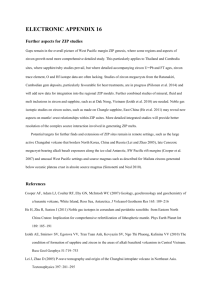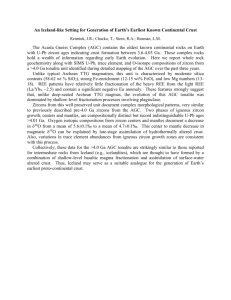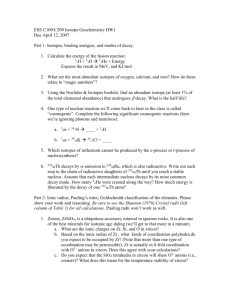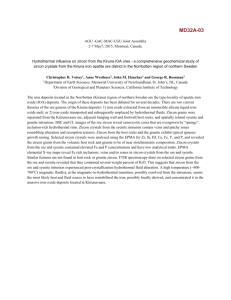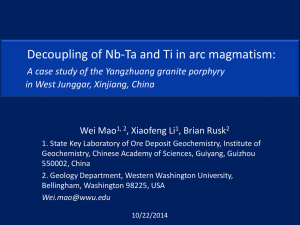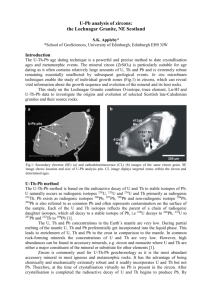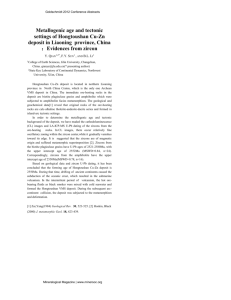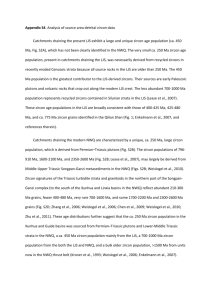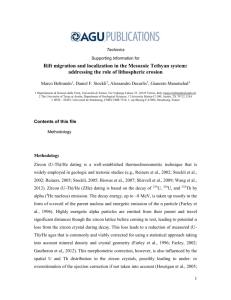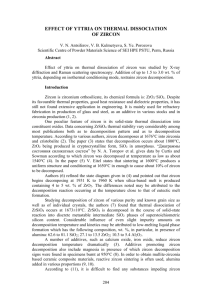METALLOGENY OF THE ALTAIDS –
advertisement
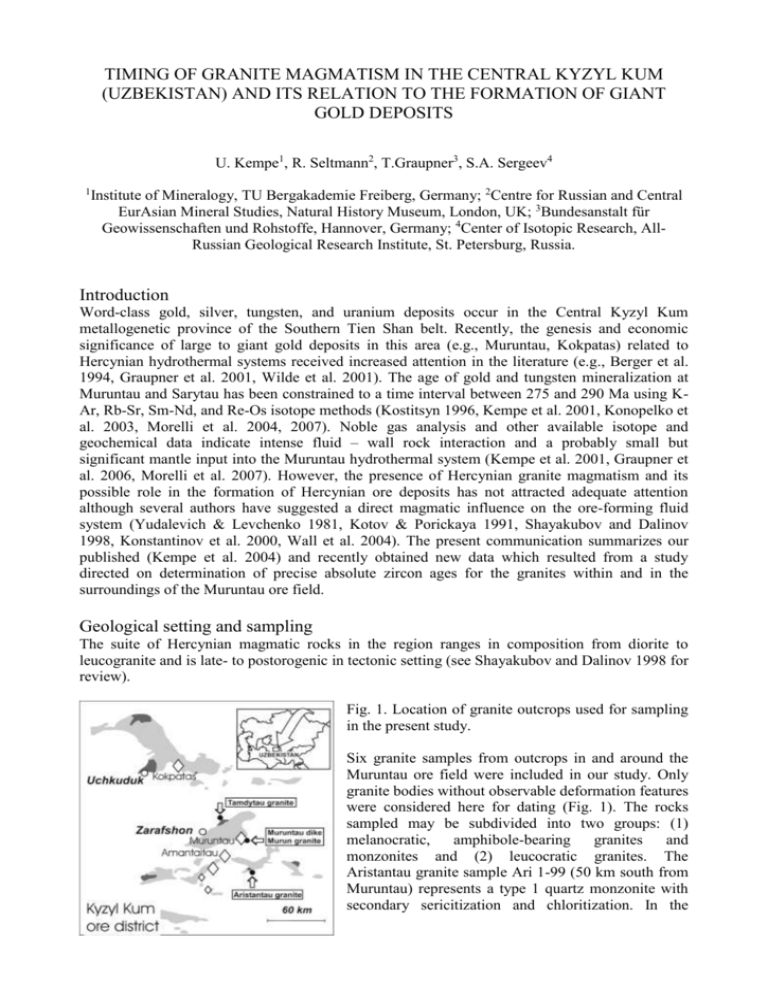
TIMING OF GRANITE MAGMATISM IN THE CENTRAL KYZYL KUM (UZBEKISTAN) AND ITS RELATION TO THE FORMATION OF GIANT GOLD DEPOSITS U. Kempe1, R. Seltmann2, T.Graupner3, S.A. Sergeev4 1 Institute of Mineralogy, TU Bergakademie Freiberg, Germany; 2Centre for Russian and Central EurAsian Mineral Studies, Natural History Museum, London, UK; 3Bundesanstalt für Geowissenschaften und Rohstoffe, Hannover, Germany; 4Center of Isotopic Research, AllRussian Geological Research Institute, St. Petersburg, Russia. Introduction Word-class gold, silver, tungsten, and uranium deposits occur in the Central Kyzyl Kum metallogenetic province of the Southern Tien Shan belt. Recently, the genesis and economic significance of large to giant gold deposits in this area (e.g., Muruntau, Kokpatas) related to Hercynian hydrothermal systems received increased attention in the literature (e.g., Berger et al. 1994, Graupner et al. 2001, Wilde et al. 2001). The age of gold and tungsten mineralization at Muruntau and Sarytau has been constrained to a time interval between 275 and 290 Ma using KAr, Rb-Sr, Sm-Nd, and Re-Os isotope methods (Kostitsyn 1996, Kempe et al. 2001, Konopelko et al. 2003, Morelli et al. 2004, 2007). Noble gas analysis and other available isotope and geochemical data indicate intense fluid – wall rock interaction and a probably small but significant mantle input into the Muruntau hydrothermal system (Kempe et al. 2001, Graupner et al. 2006, Morelli et al. 2007). However, the presence of Hercynian granite magmatism and its possible role in the formation of Hercynian ore deposits has not attracted adequate attention although several authors have suggested a direct magmatic influence on the ore-forming fluid system (Yudalevich & Levchenko 1981, Kotov & Porickaya 1991, Shayakubov and Dalinov 1998, Konstantinov et al. 2000, Wall et al. 2004). The present communication summarizes our published (Kempe et al. 2004) and recently obtained new data which resulted from a study directed on determination of precise absolute zircon ages for the granites within and in the surroundings of the Muruntau ore field. Geological setting and sampling The suite of Hercynian magmatic rocks in the region ranges in composition from diorite to leucogranite and is late- to postorogenic in tectonic setting (see Shayakubov and Dalinov 1998 for review). Fig. 1. Location of granite outcrops used for sampling in the present study. Six granite samples from outcrops in and around the Muruntau ore field were included in our study. Only granite bodies without observable deformation features were considered here for dating (Fig. 1). The rocks sampled may be subdivided into two groups: (1) melanocratic, amphibole-bearing granites and monzonites and (2) leucocratic granites. The Aristantau granite sample Ari 1-99 (50 km south from Muruntau) represents a type 1 quartz monzonite with secondary sericitization and chloritization. In the Tamdytau area (30 km to the northwest from Muruntau), a rock of similar type is exposed (sample MT 45) but with pronounced albitization as the leading alteration process. A dike sample from the Muruntau deposit (MT 168) may be added to this group using chemical criteria and zircon morphology. Primary characteristics are obliterated by intense albitization, chloritization, sericitization, and sulfide mineralization. The type 2 granites are represented by two samples from the Tamdytau granite massif (MT 44 and 43) with intense albitization (both samples) and sericitization (MT 43). These rocks show intrusive relations to the melanocratic granite (sample MT 45). A sample from the deep drill hole SG-10 south of Muruntau (MT 42318) represents the Murun leucogranite discovered more than 4004 m below surface. This granite is intensely altered by K-feldspatization, albitization, and (local) sulfide mineralization but may be recognized as a type 2 rock according to whole rock characteristics. Methods Rock samples were investigated by conventional chemical whole rock analysis (XRF, ICP-MS, INA) and a combination of optical (OM) and analytical scanning electron microscopy (SE, BSE, CL, EDX). Zircon separates were obtained by standard techniques except sample MT 42318 for which sample volume was too small. Zircon morphology was investigated using SE imaging and applying criteria proposed by Pupin (1980) for dominant prisms and pyramids. Pb-Pb dating of zircon was performed for zircon from samples Ari 1-99 and MT 168 using the evaporation technique after Kober (1986, 1987). SHRIMP dating of zircon was carried out using SHRIMP-II facility at the CIR (VSEGEI, St. Petersburg, Russia) for zircon from samples Ari 1-99, MT 45, MT 44, MT 43 and MT 42318 (direct dating of zircon in a thin section of the rock for the latter case). Internal structure of zircon was checked using SE, BSE, and CL imaging of polished grains and EDX analysis. Results Pb-Pb and U-Pb dating of zircon yields consistent ages between 288 and 296 Ma which are, in general, indistinguishable from each other within error (Fig. 2). Only most precise measurements were used for age calculation excluding data related to older “cores” in each case. On first glass, these ages may be understood as intrusion ages of the related granites. Note that our U-Pb and PbPb zircon ages are somewhat higher than reported Rb-Sr isochron ages from the literature (e.g., Kostitsyn 1996). This is not surprisingly because it is well known that the Rb-Sr system of granitic rocks is often somewhat disturbed by later alteration processes yielding too young intrusion “ages”. There are, however, some serious difficulties with such a straight forward interpretation of our data. First, it turns out that the geological younger Tamdytau leucogranite (MT 44) yields a significant older apparent “intrusion age” (393.3±2.1 Ma, MSWD 0.55, n=6) than the adjacent geological older melanogranite (MT 45; 387.7±1.4 Ma, MSWD 0.83, n=9). Moreover, Nemchin (2002, written communication) reported a highly precise, concordant U-Pb zircon age of 236.5±1.4 Ma (MSWD 1.07, n=3) for an altered granitic dike from Muruntau using conventional U-Pb dating techniques. A r i 1- 9 9 206 P b/ 207 P b e v a por a t i on 206 P b/ 238 U S HRIMP 206 P b/ 207 P b e v a por a t i on A r i 1- 9 9 M T 18 6 M T 45 c onc or di a a ge S H R I M P M T 44 c onc or di a a ge S H R I M P M T 43 c onc or di a a ge S H R I M P M T 4 2 3 18 si ngl e 280 285 290 295 age (M a) 300 206 305 P b/ 238 U 310 Fig. 2. Comparision of Pb-Pb evaporation and U-Pb SHRIMP ages of zircons from granitoids from the Muruntau area. Closer inspection of SHRIMP results as well as of mineralogical and petrologic data clearly shows that albitization of granitoid rocks is accompanied by growth of U- rich hydrothermal zircon with up to 3 wt % U mainly forming overgrowth on older zircon crystals (MT 45, MT 44, MT 43) but also separate new grains (MT 42318). On the other hand, this new, U-rich zircon is most easily affected by later alteration with a related appearance of direct (sericitization of plagioclase and biotite) and reverse (replacement of zircon by thorite-coffinite) U-Pb age discordances. There is, therefore, good evidence that dating of U-rich, weakly altered zircon constraints the age of albitization at a narrow time interval between 290 and 293 Ma. It is important to note here that apparently concordant U-Pb SHRIMP ages obtained for zircon may – as in our case - represent minimum intrusion ages but not necessarily the “true” intrusion age of the granite and that even meaningless, apparently concordant U-Pb ages may be obtained for altered zircon. Possibly, this may resolve the apparent discrepancy between our SHRIMP and evaporation age data and those obtained by Nemchin (2002, written communication) using common U-Pb techniques. Our data shows that the intrusion age of the Hercynian granitoids should be somewhat higher than 290-293 Ma. However, only a crude estimate of 293-300 Ma may be given here. Relation to gold mineralization The time intervals constrained for the intrusion of Hercynian granites and formation of gold mineralization in the Muruntau area overlap within analytical errors with each other (Fig. 3). ( 1) gr a ni t oi ds P b/ P b a nd U / P b z i r c on R b - Sr w h o l e r o c k R b - Sr w h o l e r o c k R b - Sr mi n e r a l i s o c h r o n U / P b z i r c on ( 2 ) A u m i ne r a l i sa t i on R e - Os a r s e nopy r i t e Sm- N d s c h e e l i t e 2 R b - Sr mi n e r a l i s o c h r o n R b - Sr mi n e r a l i s o c h r o n K - A r bi ot i t e K - A r bi ot i t e Fig. 3. Compilation of age data for granite magmatism and gold mineralization in the Muruntau area (literature data from Kostitsyn 1996, Kempe et al. 2001, Wilde et al. 2001, Nemchin 2002). K - A r mi c r o c l i n e K - A r a mp h i b o l e Ar -Ar ser i ci te We obtained somewhat older ages for granite 200 220 240 260 280 300 320 340 magmatism than for gold age (Ma) mineralization. Whether or not there is a significant time gap between magmatism and mineralization should be a topic of further studies. Nevertheless, our results demonstrate that there should be at least a general genetic link between granite magmatism and ore formation both related to a common tectonic process in the upper mantle/lower crust region of the Southern Tien Shan during Hercynian collision.
